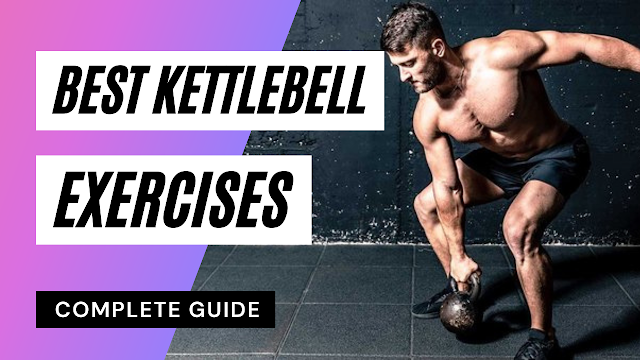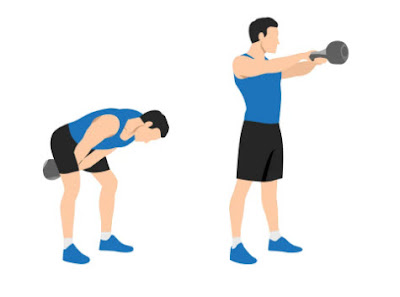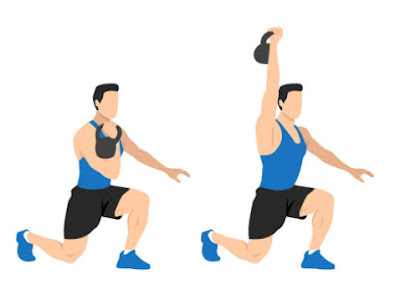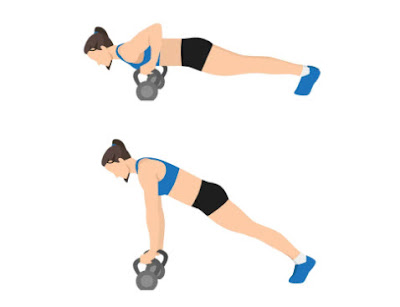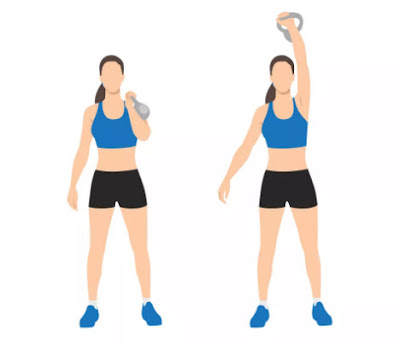Kettlebell Exercises has gained immense popularity in recent years due to its effectiveness in improving strength, cardiovascular fitness, and overall body conditioning. Originating from Russia, kettlebells are versatile exercise tools that resemble cannonballs with handles.
In this article, we will provide an in-depth exploration of kettlebell exercises, highlighting their numerous benefits, essential movements for beginners, advanced exercises for strength and power, workouts for cardiovascular fitness and full-body conditioning, important tips for safe training, and ways to incorporate kettlebell exercises into your fitness routine.
Whether you are a beginner or a seasoned fitness enthusiast, this comprehensive guide will help you harness the power of kettlebell training to elevate your fitness level and achieve your goals.
You won't believe how much information this article provides!
Well let's start.
What Are Kettlebell Exercises?
Kettlebells may look like a cross between a cannonball and a handle, but don't be fooled by their unconventional appearance. These compact and versatile tools have been around for centuries and can take your fitness game to a whole new level. Whether you're a gym newbie or a seasoned athlete, incorporating kettlebell exercises into your routine will give you a killer workout that targets multiple muscle groups at once.
The Origins and History of Kettlebell Exercises
Before trendy fitness gadgets and the rise of athleisure wear, there were kettlebells. Originating in Russia in the 18th century, kettlebell training was initially used by strongmen and military personnel. These iron weights quickly gained popularity for their ability to develop strength, endurance, and total-body power. Fast forward to today, and kettlebell exercises have become a staple in the fitness world, offering a dynamic and efficient way to sculpt your body.
The Advantages of Kettlebell Exercises
Why has kettlebell training stood the test of time? Well, besides its cool name, kettlebell training has some serious advantages. First off, these babies provide a killer total body workout. Unlike other exercises that just target one muscle group at a time, kettlebell exercises engage multiple muscle groups simultaneously, giving you more bang for your buck. Plus, kettlebells are like the Swiss Army knives of the fitness world. With just one compact weight, you can perform a wide range of exercises, from squats to swings to presses, making them a versatile tool for anyone looking to get stronger and fitter.
Benefits of Kettlebell Exercises
1.Improved Strength and Power
If you want to level up your strength and power game, kettlebell exercises are here to save the day. These workouts challenge your muscles in unique ways, helping you build functional strength that translates into real-life activities. Whether you're lifting heavy objects at work or simply trying to open a stubborn jar of pickles, kettlebell training will have you feeling like the Incredible Hulk in no time.
2.Enhanced Cardiovascular Fitness
Who says cardio has to be all about running on a boring treadmill? Kettlebell exercises are a fantastic way to improve your cardiovascular fitness while having a blast. With their dynamic and explosive movements, like kettlebell swings, you'll get your heart pumping and sweat dripping, all while feeling like a badass warrior. Say goodbye to mind-numbing cardio machines and hello to a fun and effective way to get your heart rate up.
3.Increased Core Stability and Balance
Nobody likes feeling wobbly and off-balance, especially when walking on tightropes or attempting to do yoga poses on paddleboards (we've all been there...or maybe just in our imagination?). Luckily, kettlebell exercises can help improve your core stability and balance, making you feel more grounded and steady in all your endeavors. So whether you're trying to perfect your warrior pose or simply navigate through a crowded subway, kettlebell training has your back.
The Best Kettlebell Exercises List You Need For Every Muscle
Equipment: kettlebell (If you’re new to kettlebell workouts, go for 4 kg to 12 kg. If that feels too easy and your form is perfect, try going up in weight by 2 to 4 kg.)
1. kettlebell deadlifts
Muscles worked: glutes, quads, back muscles
Reps: 6-8
How to do
- Stand with feet shoulder-width apart.
- Place a kettlebell just outside each foot on the floor.
- Engage your abdominal muscles and draw your shoulders down as you squeeze shoulder blades together.
- Push hips back and bend knees to reach kettlebell handles.
- Firmly grip kettlebells, keeping arms and back straight and feet flat on floor.
- Slowly lift chest and press hips forward until you’re standing up straight.
- Pause and inhale before lowering your body.
- Repeat 6 to 8 times. Perform 1 set to start, and work up to 3 to 4 sets as you build up your strength.
2. Kettlebell swing
Muscles worked: glutes, quads, hamstrings, arms, shoulders
Reps: Do as many swings as you can manage in 20 seconds while also keeping proper form. Rest for 30 seconds, then repeat.
How to do
- Stand with feet shoulder-width apart, with a kettlebell centered just in front of your feet on the floor.
- Engage abdominal muscles and roll shoulders back.
- Push hips back and bend knees.
- Grab kettlebell with both arms.
- Inhale and pull the kettlebell back quickly until your wrists are between your thighs and the kettlebell is slightly behind your legs, near your butt.
- Exhale as you make an explosive forward movement with hips to swing kettlebell upward and out in front of you.
- Your arms should finish parallel to the floor.
- In one motion, lower chest towards the floor and push hips back, to swing kettlebell between your legs and behind you.
- Repeat for 20 seconds. Rest for 30 seconds, then repeat for another 20 seconds. As you build up your strength, try to shoot for 6 to 7 sets of 20 seconds each.
3. Kettlebell goblet squat
Muscles worked: quads, hamstrings, calves, glutes, abdominal muscles
Reps: 6-8
How to do
- Stand with feet a little wider than shoulder-width apart, toes pointed out slightly.
- Hold a kettlebell with both hands around the sides of the handle, not from the top of the handle, and keep it close to your chest.
- Slowly bend both knees so that thighs are almost parallel to the floor. Keep elbows forward and back straight.
- Using your leg muscles, with your upper body still, stand up to your starting position. Your feet should remain firmly on the floor.
- Repeat 6 to 8 times. Perform 1 set to start, and work up to 3 to 4 sets as you build up your strength.
4. Kettlebell lunge
Muscles worked: glutes, quads, hamstrings
Reps: 6-8
You can hold a kettlebell in both hands to increase the difficulty.
How to do
- Stand with feet together.
- Hold kettlebell by the handle in your right hand, arm by your side.
- Keep shoulders back and chest upright.
- Slowly step forward with left leg, bending knee while keeping right foot in place.
- Pause for a few seconds, then push down through your forward leg to move your body upward to standing.
- After you finish your reps on one leg, switch sides so that the kettlebell is in your left hand and your right leg steps forward.
- Shoot for 1 set of 6 to 8 reps on each leg to begin. Aim to do 3 to 4 sets as you build up your fitness.
5. kettlebell Russian twist
Muscles worked: abdominal muscles, obliques
Reps: 6-8
How to do
- Sit with your legs bent, feet flat on the floor.
- Holding the kettlebell handle with both hands, lean back so that your torso is at about a 45-degree angle to the floor.
- With heels a few inches above the floor, rotate your torso from right to left, swinging the kettlebell slightly across your body.
- Rotate from side to side 6 to 8 times.
- When you’ve completed your repetitions, return to your starting position.
- Do 1 set to start. Try to work up to 3 to 4 sets as you build your fitness and strength.
6. Kettlebell pushup
Muscles worked: pecs, shoulders, triceps, core
Reps: 6-8
How to do
- Place two kettlebells approximately shoulder-width apart on the floor.
- Grip the handle of each one, and assume a pushup position. Feel free to use a modified pushup position if that’s more doable for you.
- Keeping your core engaged, back straight, and upper body rigid, lower body toward floor.
- When your chest is even with the kettlebell handles, exhale and push your body back up to its starting position.
- Repeat, always being careful not to arch your back.
- Repeat 6 to 8 times and do 1 set to start. Aim for 3 to 4 sets as you get stronger.
7. Kettlebell shoulder press
Muscles worked: triceps, shoulders
Reps: 6-8
How to do
- Stand with feet about shoulder-width apart.
- Hold a kettlebell by the handle with your right hand so that it rests against the outside part of your right shoulder. The palm side of your hand should be facing your chin, and your elbow should be close to your body.
- While exhaling, push the kettlebell upward so that your arm is almost straight overhead.
- Slowly lower the kettlebell to its starting position, keeping wrist and forearm in a neutral position and elbow close to your body.
- Do 6 to 8 repetitions with one arm, and then switch arms. Aim for 1 set with each arm to begin. Try to work up to 3 to 4 sets for each arm as you become more advanced.
8.Kettlebell One-Arm Row
Reps: 6-8
How To Do
- Stand with one foot forward, and one foot back, toes pointed slightly out. The kettlebell should sit next to your front foot, on the inside.
- The arm on the back foot side will do the row. As such, place your other arm across your front thigh to brace your upper body. Keep your back straight and core engaged.
- Hold the kettlebell hand in your rowing hand, palm facing in.
- Pull the weight up towards your chest. Keep your elbow tucked close to your torso, but allow it to extend behind your body. Focus on not letting your torso twist.
- Release the weight back down with control.
- Complete the set on one side before switching arms.
Essential Kettlebell Exercises for Beginners
1.Goblet Squats
If you want a killer leg workout that also works your core and upper body, goblet squats are the way to go. Hold a kettlebell close to your chest, lower yourself into a squat, and explode back up like a jack-in-the-box. It's like doing a regular squat, but with an extra kick of awesomeness.
2.Kettlebell Swings
Prepare to swing your way to a stronger posterior chain (that's fancy talk for your backside). Kettlebell swings are a dynamic, explosive movement that targets your glutes, hamstrings, and lower back. Plus, they'll give you a good forearm workout as you grip that kettlebell for dear life. Swing away, my friend!
3.Single-Arm Kettlebell Press
Want sculpted and strong shoulders? The single-arm kettlebell press is your golden ticket. Hold a kettlebell at shoulder height, press it up overhead, and bask in the glory of your newfound strength. This exercise not only works your shoulders but also engages your core as you stabilize yourself. It's a win-win, really.
Advanced Kettlebell Exercises for Strength and Power
1.Turkish Get-Ups
No, we're not talking about getting up from your couch to grab more snacks (although that's an exercise in itself). Turkish get-ups are a full-body movement that will challenge your strength, stability, and coordination. It's like doing a yoga flow while holding a kettlebell, without any of the pretzel-like flexibility. Give it a try, and you'll be amazed at how badass you feel.
2.Kettlebell Snatches
Feel like you need a little extra oomph in your workout? Say hello to kettlebell snatches. This explosive exercise not only builds power and strength but also pushes your cardiovascular fitness to the max. It's a full-body movement that requires coordination and a touch of finesse. So grab that kettlebell, swing it up, and let it soar like a majestic eagle (or more realistically, just above your head).
3.Double Kettlebell Front Squats
Ready to take your squat game to the next level? Double kettlebell front squats will do just that. By adding an extra kettlebell to the mix, you'll challenge your core, upper body, and lower body like never before. It's like doing a regular squat, but with double the fun (and double the burn).
Now that you've got the lowdown on kettlebell exercises, it's time to grab your trusty kettlebell, channel your inner warrior, and unleash the beast within. Let the kettlebell revolution begin!
Kettlebell Exercises for Cardiovascular Fitness
1.Kettlebell Cardio Circuit
Want to get your heart pumping and torch some calories? Look no further than the kettlebell cardio circuit. This high-energy workout combines kettlebell exercises with bursts of cardio to give you a killer cardiovascular workout. Try a circuit that includes exercises like kettlebell swings, kettlebell thrusters, and kettlebell high pulls. Perform each exercise for a set amount of time or number of repetitions, then move on to the next exercise without taking a break. Repeat the circuit for several rounds to really get your heart rate up and improve your cardiovascular fitness.
2.Kettlebell HIIT (High-Intensity Interval Training)
If you're short on time but still want an effective cardiovascular workout, kettlebell HIIT is the way to go. High-intensity interval training involves alternating between short bursts of intense exercise and brief recovery periods. With kettlebell HIIT, you can choose a variety of exercises such as kettlebell swings, kettlebell snatches, or kettlebell clean and presses. Perform each exercise at maximum effort for a set amount of time, followed by a short rest period. Repeat this cycle for multiple rounds to challenge your cardiovascular system and improve your overall fitness.
3.Kettlebell Complexes
For a cardiovascular workout that also targets multiple muscle groups, try kettlebell complexes. A complex is a series of exercises performed back-to-back without putting the kettlebell down. This continuous movement keeps your heart rate elevated while providing a full-body workout. Create a complex using exercises like kettlebell squats, kettlebell lunges, kettlebell push presses, and kettlebell rows. Perform each exercise for a set number of repetitions, then move on to the next exercise without resting. Complete multiple rounds of the complex to build endurance and enhance your cardiovascular fitness.
Kettlebell Workouts for Full Body Conditioning
1.Kettlebell Full Body Circuit
Looking for a workout that targets all major muscle groups? The kettlebell full body circuit is your answer. This workout incorporates exercises that engage your upper body, lower body, and core, giving you a comprehensive full-body conditioning session. Combine movements like kettlebell deadlifts, kettlebell overhead presses, kettlebell goblet squats, and kettlebell Russian twists. Perform each exercise for a specific number of repetitions or a set amount of time, going from one exercise to the next without resting. Repeat the circuit for multiple rounds to improve your strength, endurance, and overall body composition.
2.Kettlebell Tabata Workout
Short on time but still want an intense full-body workout? Enter the kettlebell Tabata workout. Tabata training consists of 20 seconds of all-out effort followed by 10 seconds of rest, repeated for multiple rounds. Choose exercises such as kettlebell swings, kettlebell cleans, kettlebell goblet squats, and kettlebell renegade rows. Perform each exercise at maximum intensity for 20 seconds, then take a 10-second break before moving on to the next exercise. Repeat the cycle for several rounds to challenge your entire body and improve your muscular endurance.
3.Kettlebell Pyramid Training
If you're up for a challenging workout that builds strength and endurance, give kettlebell pyramid training a try. Start with a light kettlebell and perform a set number of repetitions for an exercise like kettlebell goblet squats. Then, increase the weight and decrease the repetitions for the next set. Continue this pattern, gradually increasing the weight and decreasing the repetitions with each set until you reach your heaviest weight. After reaching the peak, work your way back down the pyramid, decreasing the weight and increasing the repetitions. This type of training not only challenges your muscles but also provides a great cardiovascular workout.
Tips and Techniques for Safe and Effective Kettlebell Training
1.Choosing the Right Kettlebell Weight
When starting with kettlebell exercises, it's crucial to choose the right weight for your current fitness level and experience. Start with a lighter kettlebell to focus on technique and form before progressing to heavier weights. The weight should challenge you but still allow you to perform the exercises with proper form and without compromising your safety.
2.Proper Kettlebell Grip and Stance
To ensure a secure and effective workout, it's important to master the proper kettlebell grip and stance. When gripping the kettlebell, wrap your fingers firmly around the handle and keep your thumb pointing towards the bell. Maintain a neutral wrist position to avoid strain. Additionally, having a stable stance with your feet shoulder-width apart, knees slightly bent, and core engaged will provide a solid foundation for executing the exercises with control and stability.
3.Breathing Techniques during Kettlebell Exercises
Breathing plays a significant role in kettlebell exercises. It's essential to maintain a consistent breathing pattern throughout each movement. During the concentric phase (the exertion phase) of an exercise, exhale forcefully, and during the eccentric phase (the return phase), inhale deeply. This technique helps stabilize your core and provides additional power during the movements. Remember to keep your breathing natural and avoid holding your breath, as it can lead to unnecessary tension and fatigue.
Incorporating Kettlebell Exercises into Your Fitness Routine
1.Kettlebell Workouts for Strength Training
If you're looking to build strength, kettlebell exercises are an excellent addition to your fitness routine. Incorporate exercises like kettlebell deadlifts, kettlebell presses, kettlebell rows, and kettlebell Turkish get-ups to target different muscle groups. Perform these exercises with heavier weights and lower repetitions to maximize strength gains. Be sure to focus on maintaining proper form and gradually progress in weight to continue challenging your muscles.
2.Kettlebell Workouts for Fat Loss
To shed unwanted body fat, kettlebell workouts can be highly effective. Incorporate exercises that involve full-body movements and engage multiple muscle groups, such as kettlebell swings, kettlebell snatches, and kettlebell clean and jerks. Perform these exercises with higher repetitions and shorter rest periods to keep your heart rate elevated and maximize calorie burn. Combine these workouts with a healthy diet and consistent cardio exercise for optimal fat loss results.
3.Combining Kettlebell Exercises with Other Training Modalities
Kettlebell exercises can be a fantastic complement to other training modalities. Whether you enjoy running, cycling, or practicing yoga, incorporating kettlebell training can enhance your overall fitness level. Use kettlebell exercises as a warm-up or finisher to your regular workouts. For example, perform kettlebell swings before a run to activate your posterior chain or include kettlebell goblet squats at the end of a strength training session to further challenge your legs.
Experiment with different combinations to find what works best for you and adds variety to your fitness routine.
In conclusion
kettlebell exercises offer a dynamic and efficient way to improve strength, endurance, and overall fitness. Whether you're aiming to build muscle, lose weight, or enhance athletic performance, incorporating kettlebell workouts into your routine can yield impressive results. Remember to start with the basics and gradually progress to more advanced exercises, always focusing on proper form and technique. With consistency and dedication, kettlebell training can take your fitness journey to new heights. So grab a kettlebell, embrace the challenge, and enjoy the countless benefits these versatile tools have to offer. Get ready to transform your body and achieve your fitness goals with the power of kettlebell exercises.
Frequently Asked Question (FAQ)
1. Can anyone do kettlebell exercises, or is it only for advanced fitness enthusiasts?
Kettlebell exercises can be adapted to suit individuals of various fitness levels. Beginners can start with lighter weights and focus on mastering proper form and technique before progressing to more advanced movements. It is essential to consult with a fitness professional or trainer to ensure safe and effective kettlebell training.
2. Are kettlebell exercises suitable for weight loss?
Yes, kettlebell exercises can be highly effective for weight loss. The combination of strength training and cardiovascular conditioning in kettlebell workouts helps to increase calorie burn, build muscle mass, and boost metabolism. However, it is important to complement kettlebell training with a balanced diet and overall healthy lifestyle for optimal weight loss results.
3. Can kettlebell exercises replace traditional weightlifting exercises?
Kettlebell exercises offer unique benefits and can be a valuable addition to a well-rounded fitness routine. However, they should not necessarily be seen as a complete replacement for traditional weightlifting exercises. Incorporating a variety of training modalities, including kettlebells, barbells, and bodyweight exercises, can provide comprehensive strength and muscle development.
4. Is it possible to get injured while doing kettlebell exercises?
As with any form of exercise, there is a risk of injury if proper form and technique are not followed during kettlebell exercises. It is crucial to start with lighter weights, focus on maintaining proper alignment, engage the core muscles, and gradually increase intensity as strength and proficiency improve. Additionally, seeking guidance from a qualified instructor can greatly reduce the risk of injury.
These are Best Kettlebell Exercises List You Need
What do you think of this guide?
Let me know by leaving a comment below, and don't forget to share this guide if you found it helpful.
